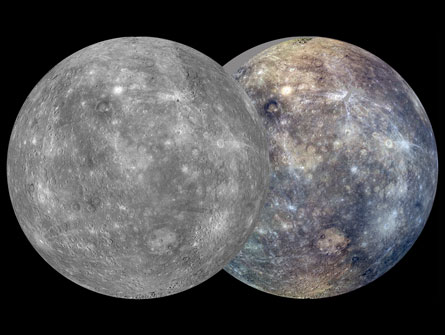Messages from Mercury
After orbiting the solar system’s smallest, innermost planet for just six months, NASA’s MESSENGER spacecraft is relaying some intriguing observations. For one, MESSENGER team members reported October 5, Mercury’s magnetic field is offset from the planet’s core: it’s centered 480 kilometers to the north of center, a distance roughly 20 percent that of the planet’s diameter. Atmospheric calcium curiously clusters near the planet’s equator at dawn. And a 99 percent complete surface map reveals a complex area of former volcanic activity in the northern hemisphere. It’s also possible for ice to exist on this smoldering world: as is true for Earth’s moon, there are perpetually shadowed hollows in Mercury’s surface. At the poles, these areas are tucked into craters — super-shady places that make perfect hidey-holes for ice. — Nadia Drake

Kepler’s Three Musketeers
One of the 170 planetary systems detected by NASA’s Kepler spacecraft includes three tightly packed planets orbiting a sunlike star. With an orbit within Mercury’s distance from the sun, one of the planets is a super-Earth that whizzes around its star every 3.5 Earth-days. The next planet, Neptune-sized, completes its exo-year in 7.6 days, and the furthest away — a second Neptune — takes a leisurely 14.9 day path. Astronomers used a statistical method to infer the presence of the innermost planet, said Bill Cochran of the University of Texas at Austin, who presented the find on October 4. — Nadia Drake
Three distant dwarfs
Scientists spying on dwarf planets in the Kuiper Belt have used stellar occultations — when a planet passes between Earth and a star — to determine some physical features of the distant worlds Eris, Makemake and Quaoar. Quaoar is bigger, less dense than previously thought, and might be missing a big chunk. Makemake is elliptical, somewhat flattened — perhaps because it spins so quickly — and has two different types of surface terrain, astronomers reported on October 4. Eris, Pluto’s rival for the biggest dwarf, is essentially Pluto’s twin – but very bright, and potentially covered in a collapsed atmosphere. — Nadia Drake
Enceladean snowstorm
It’s snowing on Saturn’s moon Enceladus, and probably has been for tens of millions of years. Snow cover on the icy moon may be 100 meters deep in places — that’s the length of three blue whales — and is produced by the icy particles bursting from the moon’s south polar geysers. Scientists studying the plume determined that some of the heavier particles can re-accrete and snow on the surface, producing observable color asymmetries. The rest fly off into the Saturnian system where they water the giant planet and craft its E ring. The Enceladean snow fields indicate that the south polar geysers may have been erupting for as long as 100 million years, Paul Schenk of the Lunar and Planetary Institute in Houston said October 3. — Nadia Drake
Unlucky Uranus
Getting knocked around in the early solar system is no new idea — ’twas apparently a lot like bumper cars on steroids back then — but Uranus may have suffered a one-two punch that explains its peculiar orientation. The planet is tipped 98 degrees — it’s on its side. And its moons didn’t notice and reorient themselves. They orbit askew, too. On October 6, Alessandro Morbidelli of the Cote d’Azur Observatory in Nice, France, explained this observation by suggesting that it was not one impact but two that toppled the planet. The first got only part of the job done. The second came in and finished it off. — Nadia Drake
Signs of climate change on Titan
Earth may not be the only body in the solar system experiencing significant changes in climate. Saturn’s moon Titan might be, too, Jani Radebaugh of Brigham Young University in Provo, Utah, suggested October 4. While equatorial sand dunes cover millions of square kilometers on Titan, the dunes are missing near the poles. At high latitudes, the moon is covered with landforms resembling older dunes. Radebaugh says that desert conditions may once have allowed dune formation in these areas, but that changing winds and humidity delivered liquid methane and organic cements, which have since anchored the dunes in place and altered their shape. — Nadia Drake
Enceladus’ ocean may be frozen
While it’s tempting to conclude that Enceladus must host a liquid water reservoir, an extraterrestrial salty ocean is not certain. Mikhail Zolotov of Arizona State University in Tempe suggested on October 3 that water must have been present at some point during Enceladus’ history — but that it’s not necessarily there now. In fact, the gases present in the plume are inconsistent with the presence of liquid, even though some of the plume’s ingredients require a watery birth. Zolotov says it will take some work to reconcile these observations, but suggests that a flash-frozen, formerly liquid reservoir could be lurking beneath the Saturnian moon’s crust. — Nadia Drake







